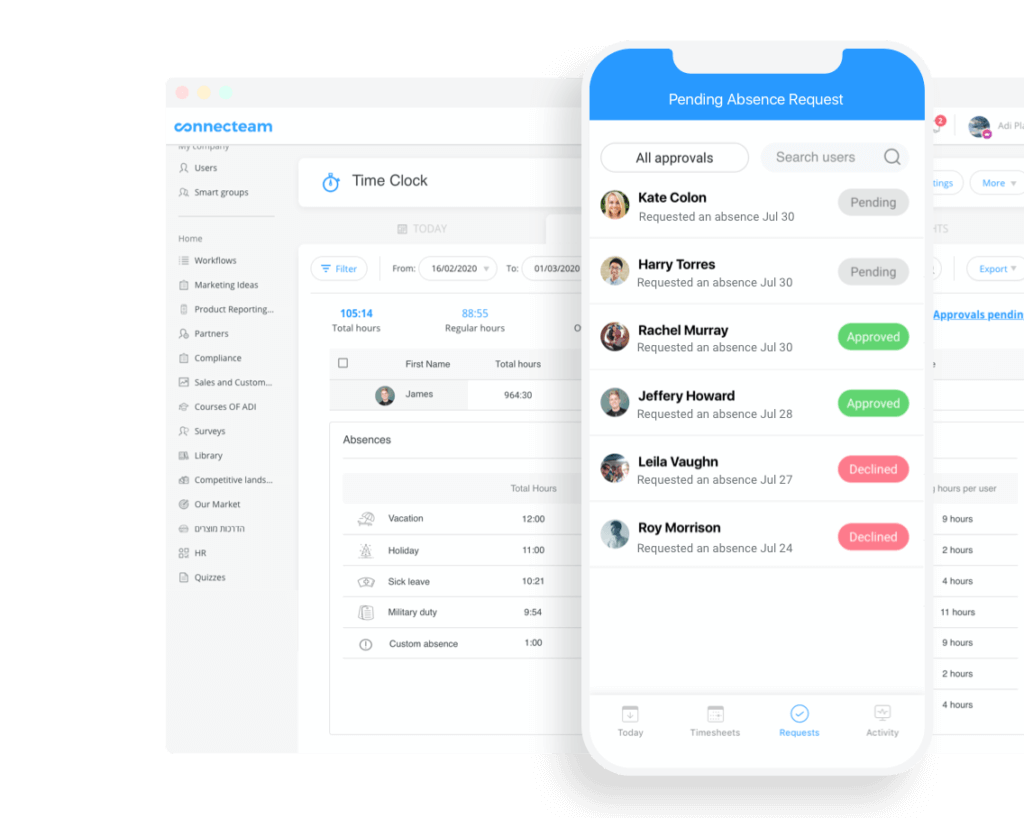Get a handle on out-of-control employee absenteeism before it costs your business hundreds of thousands in payroll expenses. We list the costs, the causes, and the solutions to manage attendance issues in the workplace.
Get a handle on out-of-control employee absenteeism before it costs your business a fortune in payroll expenses. Check out the costs, causes, and solutions to manage attendance issues in the workplace.
There are many valid reasons for your employees to be absent from work. Sick days, maternity leave, and vacations are typical valid absences.
But unplanned absences or frequently missing workers can cause a lot of trouble for your business and employees.
Unplanned absences can wreck your company’s finances, morale, and productivity.
A few random, unplanned absences aren’t worth worrying about. But, if you notice a pattern and absenteeism becomes a habit for some of your employees — it’s time to intervene and act.
Why Is Excessive Absenteeism in the Workplace a Problem?
Unfortunately, employee absenteeism is a common problem for employers and business owners.
Recently, The Workforce Institute conducted a study during the final season of Game of Thrones. This survey showed that over 34% of U.S. employees (27.2 million) admitted they’re likely to call in sick, arrive late, or be less productive than normal in the workplace.
When absenteeism becomes a habit, it also costs employers lots of money. On average, U.S. companies lose about $3,600 per hourly employee and $2,650 per salaried employee each year in lost productivity from absent workers. And those are conservative estimates. These costs increase even faster if you have hundreds or thousands of employees.
Employee absenteeism also increases the workload for present workers. Having to constantly pick up the slack for absent colleagues can contribute to feelings of burnout.
The best ways to substantially lower the impact of employee absenteeism are to:
- Create an employee attendance improvement plan.
- Design clear attendance policies.
- Have a powerful solution to manage employee attendance.
- Accurately track paid and unpaid time off.
But first, you must tackle what causes excessive absences, such as vague policies, low morale, or time-tracking problems.
What Does Employee Absenteeism Cost Your Business?
Companies often underestimate or even ignore the actual costs of employee absenteeism. With the cost of absenteeism tied to time and money, its costs often take work to measure.
Here are a few statistics highlighting how much excessive absences cost companies:
- According to the Bureau of Labor Statistics, almost 3% of the United States workforce is absent on any given day.
- In 2013, the Gallup-Healthways well-being survey estimated lost productivity costs in the U.S. to total over $84 billion… in one year!
- According to Kronos, the total cost of employee absences is more than twice the average employer’s healthcare costs.
But what factors contribute to absenteeism costs? Here’s a closer look at how employee absenteeism costs your business money.
The Direct Costs Of Absenteeism
- Losses in salary. Costs include money improperly paid to absent employees and overtime pay for replacement workers.
- Losses in work hours. Excessive or unscheduled absences also contribute to lost time.
Despite the significance of direct costs, indirect costs of absenteeism can cause an even larger impact. These indirect costs can cause work delays. Indirect costs also include the toll taking on more work has on present employees.
The Indirect Costs Of Absenteeism
- Losses in productivity and quality often happen when employees don’t show up to work. Productivity struggles happen because non-absent employees can only do so much in a workday. It’s also possible for a company’s quality of goods or services to plummet.
- Administrative costs also increase when absenteeism occurs. These costs include excessive time spent on disciplinary matters and finding suitable employee replacements.
- Safety issues occur when poorly trained employees make mistakes rushing to fill in for absent workers.
- Poor morale is another indirect absenteeism cost. Productive employees filling in to cover absent coworkers often feel taken advantage of.
Time Off Made Easy
Managing time off doesn’t have to be confusing or time-consuming. Try Connecteam’s time-off app for free!
The Most Common Causes Of Absenteeism
We’ll split the most commonly reported reasons for absenteeism in the workplace into two types: Technical and Moral.
Technical Causes of Employee Absenteeism
- Poor communication about employee availability
- Employees don’t understand absence policies.
- Inconsistent enforcement of absence-related rules
- Scheduling problems
- Home and family obligations
- Management and employee relation concerns
- A lack of solid scheduling software and employee time-tracking solutions
Moral Causes of Employee Absenteeism
- Workplace bullying or harassment from colleagues or managers
- Excessive stress that often leads to depression and burnout
- A lack of engagement and purpose
- Job hunting — yes, employees sometimes call in sick to attend a job interview or work on their resumes.
What about when employees show up to work but round-up hours and cut corners? That’s known as time theft. Check out Connecteam’s time theft guide here.
How to Address Employee Absenteeism
Create An Employee Attendance Policy
A great way to reduce employee absenteeism is with a clear attendance policy. An attendance policy sets rules for absences from work. It also lists what qualifies as an excusable absence and what doesn’t. A solution like Connecteam can digitize absence policies. These solutions let users create and update employee attendance policies quickly.
But what do your employees want regarding attendance policies? Besides wanting clear attendance policies, employees also appreciate facilitative programs over punitive ones.
Supportive measures involve working with employees to help them improve their attendance.
Punitive measures force employees to come to work – but often result in workers being absent while working.
Employees who aren’t present at work:
- Do the bare minimum
- Lack motivation
- Seem generally unhappy or stressed-out
Help your employees be present at work by offering a flexible work schedule, family care days, or job-sharing.
Simplify Absence Requests And Approvals
Many companies need help managing absences because they keep outdated policies, use outdated tools, or both. Offer clear procedures and channels for employee absence requests and reports, such as a simple mobile time clock app. A time clock app, such as Connecteam, makes clocking in and clocking out easy.
Solutions like Connecteam answer absence-related questions, including:
- Who is clocked in right now?
- How many employees clocked in today?
- Who is late and hasn’t started yet?
- Who is absent today?
- Was an absence requested and approved ahead of time?
- Who reached their daily work-time limit?
- Who worked overtime?
- Who requested a day off and why?
Simplify the absence process by implementing one system that people use company-wide. Having your employees use emails, texts, Slack messages, and other communication methods all at once is confusing and stressful.
Solutions like Connecteam let companies manage time-off-related requests from one app or program. Using a single solution to manage absences leads to more clarity and helps managers avoid the dreaded missed message. When your company has a clear communication channel for absences, it can also lead to fewer confused and angry employees.
Keep Track Of Employee Absences
Tracking absences lets you see how much time or money you lose due to excessive absenteeism. How you track time depends on what fits you or whoever’s in charge of controlling attendance.
It’s possible to track absences using a pen-and-paper system or older computer programs. But, more often than not, using outdated methods to track time takes a lot of time. Ironic, isn’t it?
Manually tracking absences can also lead to mistakes, including paying employees too little or too much for taking time off.
Many companies handle absenteeism by using an employee attendance app. These apps safely store attendance information, making it readily available for human resource managers or business owners.
An employee time clock app lets you set automatic time clock and attendance reports. These solutions can also send custom notifications that automatically report absences and time-off requests.
You can create various types of auto reports in a time-clock app, including:
- Morning reports that feature a list of clocked-in or absent employees.
- Customer reports that show employees who worked with customers.
- End-of-day reports that display all currently clocked-in users, clocked-out workers, and employees who worked overtime.
- Absence reports that include who’s not at work, how much time they’re taking off, and whether this is paid or unpaid time off.

Sidenote: Connecteam also integrates with QuickBooks Online and Gusto for instant and 100% accurate payroll.
Boost Employee Engagement by Recognizing Your Employees
In the beginning, occasional absences from employees can be hard to notice. If you don’t handle employee absences at this stage, absenteeism rates could soon skyrocket.
Sometimes, absenteeism problems start when employees feel unnoticed and disengaged. These people assume their employers ignore their accomplishments and don’t value their roles. So, these employees decide to stay home.
Recognizing your employees for their work is a great way to motivate workers. Give shout-outs for personal milestones like birthdays or work anniversaries. Treating employees well costs nothing, but it means a lot to the people who work for you.
Improve Employee Morale
Increase employee engagement and lower absenteeism by boosting morale. Set up employee appreciation days or invest in training to reduce employee absenteeism.
It sounds surprising, but training is also helpful for managing absenteeism. Up to 40% of employees receiving poor on-the-job training will leave your company within their first year of employment. When employees leave, it costs businesses much more than absenteeism-related expenses.
Encourage Better Attendance With Time-Off Banks
One of the best ways to control absences is by creating programs like PTO banks. Paid Time Off (PTO) programs give employees a specified amount of PTO to use for personal matters – without dipping into sick leave or vacation time. Using an app to track PTO banks or time-off balances is beneficial, especially when you manage large teams of employees.

Another positive attendance tool is a flexible work schedule policy. Letting employees adapt work schedules to their lives lowers their stress. When workers aren’t stressed-out, they bring increased productivity and engagement to your business.
You can also lower absenteeism in the workplace by rewarding attendance champions with prizes, incentives, or wellness programs.
Legal & Disciplinary Action
Despite all your efforts, some employees repeatedly go missing without showing any improvement.
At this point, you should consider disciplinary and legal actions to minimize your risks and losses. Check in with these employees right away — start with a casual chat to find out what’s going on and if you can help.
If informal chats don’t work, move on to an informal warning. If unscheduled absenteeism continues, consider a written notice before a final warning.
Beyond a final warning, your remaining options are to suspend or terminate an employee. Sometimes it’s cheaper to hire and train a new employee who’s the right fit.
The Bottom Line on Dealing With Absenteeism
Absenteeism at work is a huge problem for many businesses. Companies of all sizes, with hourly or salaried employees, can struggle with absenteeism.
But the foundation of this problem is always the same — it happens when:
- Your employees aren’t happy or lack a purpose.
- Your company has no solution to track absences and time-off pay.
When you reduce absenteeism, it creates happier employees and can increase your company’s revenue.
Before making company-wide changes, consider why workers aren’t showing up. Then, address these problems with a detailed absence policy and accurate time-tracking software.
Manage Absences With One Click
Simplify requests and approvals, customize absence types, and track employee absences for FREE using Connecteam.




